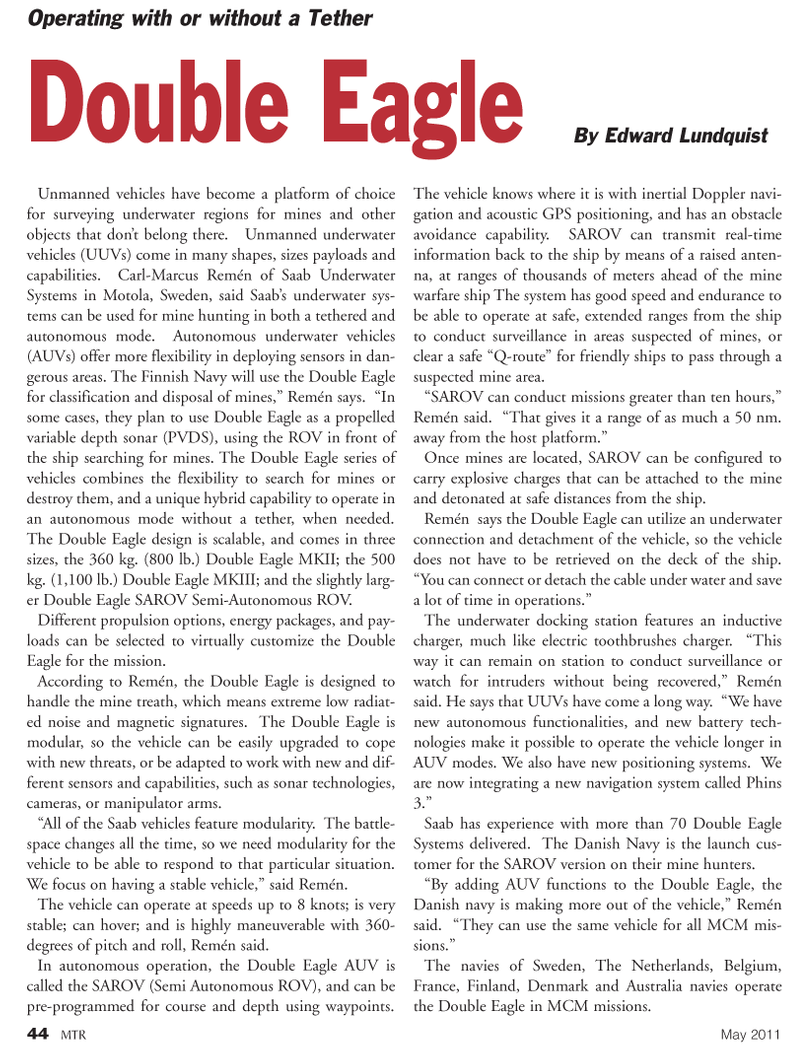
Page 44: of Marine Technology Magazine (May 2011)
Subsea Defense Edition
Read this page in Pdf, Flash or Html5 edition of May 2011 Marine Technology Magazine
Unmanned vehicles have become a platform of choice for surveying underwater regions for mines and other objects that don’t belong there. Unmanned underwater vehicles (UUVs) come in many shapes, sizes payloads and capabilities. Carl-Marcus Remén of Saab Underwater
Systems in Motola, Sweden, said Saab’s underwater sys- tems can be used for mine hunting in both a tethered and autonomous mode. Autonomous underwater vehicles (AUVs) offer more flexibility in deploying sensors in dan- gerous areas. The Finnish Navy will use the Double Eagle for classification and disposal of mines,” Remén says. “In some cases, they plan to use Double Eagle as a propelled variable depth sonar (PVDS), using the ROV in front of the ship searching for mines. The Double Eagle series of vehicles combines the flexibility to search for mines or destroy them, and a unique hybrid capability to operate in an autonomous mode without a tether, when needed.
The Double Eagle design is scalable, and comes in three sizes, the 360 kg. (800 lb.) Double Eagle MKII; the 500 kg. (1,100 lb.) Double Eagle MKIII; and the slightly larg- er Double Eagle SAROV Semi-Autonomous ROV.
Different propulsion options, energy packages, and pay- loads can be selected to virtually customize the Double
Eagle for the mission.
According to Remén, the Double Eagle is designed to handle the mine treath, which means extreme low radiat- ed noise and magnetic signatures. The Double Eagle is modular, so the vehicle can be easily upgraded to cope with new threats, or be adapted to work with new and dif- ferent sensors and capabilities, such as sonar technologies, cameras, or manipulator arms. “All of the Saab vehicles feature modularity. The battle- space changes all the time, so we need modularity for the vehicle to be able to respond to that particular situation.
We focus on having a stable vehicle,” said Remén.
The vehicle can operate at speeds up to 8 knots; is very stable; can hover; and is highly maneuverable with 360- degrees of pitch and roll, Remén said.
In autonomous operation, the Double Eagle AUV is called the SAROV (Semi Autonomous ROV), and can be pre-programmed for course and depth using waypoints.
The vehicle knows where it is with inertial Doppler navi- gation and acoustic GPS positioning, and has an obstacle avoidance capability. SAROV can transmit real-time information back to the ship by means of a raised anten- na, at ranges of thousands of meters ahead of the mine warfare ship The system has good speed and endurance to be able to operate at safe, extended ranges from the ship to conduct surveillance in areas suspected of mines, or clear a safe “Q-route” for friendly ships to pass through a suspected mine area. “SAROV can conduct missions greater than ten hours,”
Remén said. “That gives it a range of as much a 50 nm. away from the host platform.”
Once mines are located, SAROV can be configured to carry explosive charges that can be attached to the mine and detonated at safe distances from the ship.
Remén says the Double Eagle can utilize an underwater connection and detachment of the vehicle, so the vehicle does not have to be retrieved on the deck of the ship. “You can connect or detach the cable under water and save a lot of time in operations.”
The underwater docking station features an inductive charger, much like electric toothbrushes charger. “This way it can remain on station to conduct surveillance or watch for intruders without being recovered,” Remén said. He says that UUVs have come a long way. “We have new autonomous functionalities, and new battery tech- nologies make it possible to operate the vehicle longer in
AUV modes. We also have new positioning systems. We are now integrating a new navigation system called Phins 3.”
Saab has experience with more than 70 Double Eagle
Systems delivered. The Danish Navy is the launch cus- tomer for the SAROV version on their mine hunters. “By adding AUV functions to the Double Eagle, the
Danish navy is making more out of the vehicle,” Remén said. “They can use the same vehicle for all MCM mis- sions.”
The navies of Sweden, The Netherlands, Belgium,
France, Finland, Denmark and Australia navies operate the Double Eagle in MCM missions. 44 MTR May 2011
Operating with or without a Tether
Double Eagle By Edward Lundquist

 43
43

 45
45
